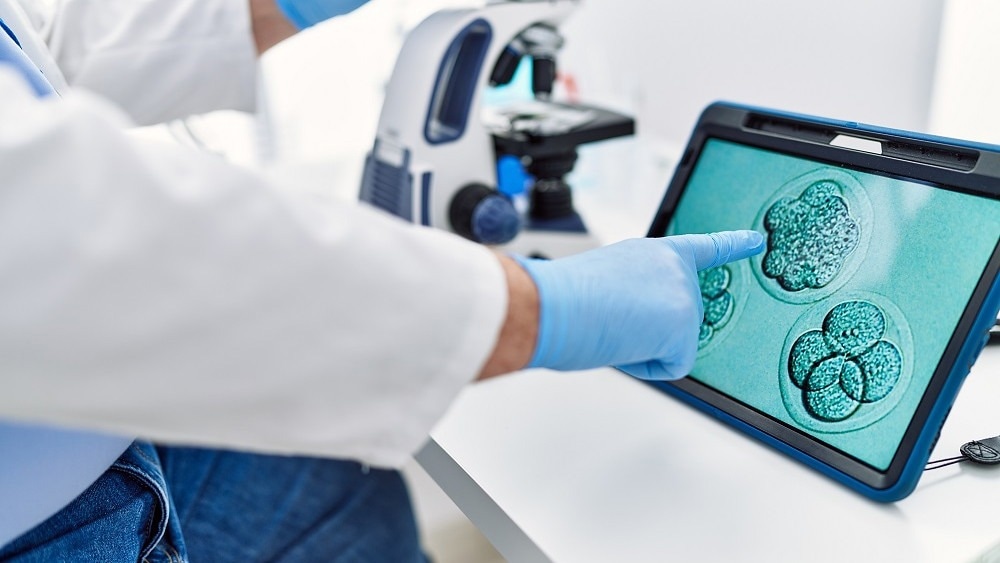Reviewed by Danielle Ellis, B.Sc.Jun 21 2023
A previously unknown type of cell that self-destructs within days of forming as part of a quality control procedure to protect the growing fetus has been found by researchers studying gene activity data of the early human embryo.
 The team found that cells containing “jumping genes” self-destructed in the early days of development. Image Credit: Krakenimages.com
The team found that cells containing “jumping genes” self-destructed in the early days of development. Image Credit: Krakenimages.com
The discoveries shed light on what occurs throughout the earliest stages of life following fertilization, which could one day help enhance IVF or regenerative medicine treatments.
An international team of scientists, including those from the University of Bath, found in a recent study that was published on 20th June 2023 in PLoS Biology, suggests that the way in which humans develop in the womb at the very beginning may not be as expected.
Although adult humans are made up of trillions of cells, the fertilized egg was where it all began. This divides into two cells, which divide into four cells, which divide into eight cells, and so on.
The cells eventually begin to specialize in their function. Some will be diverted to become the placenta, while others will become the embryo, like trains diverted to various end stations.
Self-destructing Embryonic Cell
The research team found that approximately 25% of the cells did not fit the profile of any of the known cell categories (pre-embryo, pre-placenta, etc.) after analyzing previously published data on the gene activity of each individual cell from 5-day-old embryos.
Further research revealed that these cells possessed what is known as “Young transposable elements” or “jumping genes.” These are rogue DNA components that can replicate and re-insert themselves into human DNA, frequently causing harm in the process.
The existence of the cells with proteins resulting from the jumping genes was established by staining embryos by project collaborators in Spain.
The team discovered that their descendants experience both DNA damage and programmed cell death when they ventured a bit further into the future.
Quality Control Mechanism
The researchers hypothesize that this mechanism resembles a type of quality control, selecting cells in favor of the best.
Humans, like all organisms, fight a never-ending game of cat and mouse with these harmful jumping genes. While we try and suppress these jumping genes by any means possible, very early in development they are active in some cells, probably because we cannot get our genetic defenses in place fast enough.”
Dr Zsuzsanna Izsvák, Study Co-Senior Author, Max Delbrück Center
Study co-lead author Professor Laurence Hurst, from the Milner Centre for Evolution at the University of Bath, said: “If a cell is damaged by the jumping genes—or any other sort of error such as having too few or too many chromosomes—then the embryo is better off removing these cells and not allowing them to become part of the developing baby.”
Hurst further added, “We are used to the idea of natural selection favoring one organism over another. What we are seeing within embryos also looks like survival of the fittest but this time between almost identical cells. It looks like we have uncovered a novel part of our arsenal against these harmful genetic components.”
Using Old Genetic Enemies to Fight New Ones
Contrarily, the single-cell data revealed that the inner cell mass, or ICM, or the crucial cells that will develop into the embryo, do not include jumping genes but rather express a virus-like gene known as human endogenous virus H.
This supports a developing pattern in which old genetic foes are deployed to battle the new ones, which helps suppress young jumping genes in the inner cell mass.
The authors contend that an overly sensitive quality control procedure could result in the death of the entire embryo. This could serve to explain why some abnormalities that affect the capability to recognize damage to developing embryos are also linked to infertility.
Source:
Journal reference:
Singh, M., et al. (2023). A new human embryonic cell type associated with activity of young transposable elements allows definition of the inner cell mass. PLoS Biology. doi.org/10.1371/journal.pbio.3002162